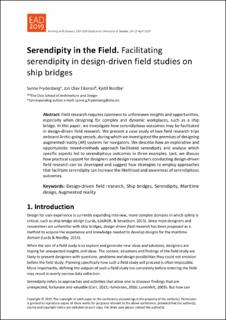| dc.contributor.author | Frydenberg, Synne Geirsdatter | |
| dc.contributor.author | Eikenes, Jon Olav Husabø | |
| dc.contributor.author | Nordby, Kjetil | |
| dc.date.accessioned | 2020-05-13T09:55:14Z | |
| dc.date.available | 2020-05-13T09:55:14Z | |
| dc.date.created | 2019-10-21T16:58:00Z | |
| dc.date.issued | 2019 | |
| dc.identifier.citation | The Design Journal. 2019, 22 (1), 1899-1912. | en_US |
| dc.identifier.issn | 1460-6925 | |
| dc.identifier.uri | https://hdl.handle.net/11250/2654205 | |
| dc.description.abstract | Field research requires openness to unforeseen insights and opportunities, especially when designing for complex and dynamic workplaces, such as a ship bridge. In this paper, we investigate how serendipitous outcomes may be facilitated
in design-driven field research. We present a case study of two field research trips onboard Arctic-going vessels, during which we investigated the premises of designing augmented reality (AR) systems for navigators. We describe how an explorative and opportunistic mixed-methods approach facilitated serendipity and analyse which specific aspects led to serendipitous outcomes in three examples. Last, we discuss how practical support for designers and design researchers conducting design-driven field research can be developed and suggest how strategies to employ approaches that facilitate serendipity can increase the likelihood and awareness of serendipitous outcomes. | |
| dc.language.iso | eng | en_US |
| dc.rights | Navngivelse-Ikkekommersiell-DelPåSammeVilkår 4.0 Internasjonal | * |
| dc.rights.uri | http://creativecommons.org/licenses/by-nc-sa/4.0/deed.no | * |
| dc.title | Serendipity in the Field. Facilitating serendipity in design-driven field studies on ship bridges | en_US |
| dc.type | Peer reviewed | en_US |
| dc.type | Journal article | en_US |
| dc.description.version | acceptedVersion | en_US |
| dc.source.pagenumber | 1899-1912 | en_US |
| dc.source.volume | 22 | en_US |
| dc.source.journal | The Design Journal | en_US |
| dc.source.issue | 1 | en_US |
| dc.identifier.doi | 10.1080/14606925.2019.1594948 | |
| dc.identifier.cristin | 1739242 | |
| cristin.ispublished | true | |
| cristin.fulltext | postprint | |
| cristin.fulltext | Field research requires openness to unforeseen insights and opportunities, especially when designing for complex and dynamic workplaces, such as a ship
bridge. In this paper, we investigate how serendipitous outcomes may be facilitated in design-driven field research. We present a case study of two field research trips onboard Arctic-going vessels, during which we investigated the premises of designing augmented reality (AR) systems for navigators. We describe how an explorative and opportunistic mixed-methods approach facilitated serendipity and analyse which specific aspects led to serendipitous outcomes in three examples. Last, we discuss how practical support for designers and design researchers conducting design-driven field research can be developed and suggest how strategies to employ approaches that facilitate serendipity can increase the likelihood and awareness of serendipitous outcomes. | |
| cristin.qualitycode | 1 | |

